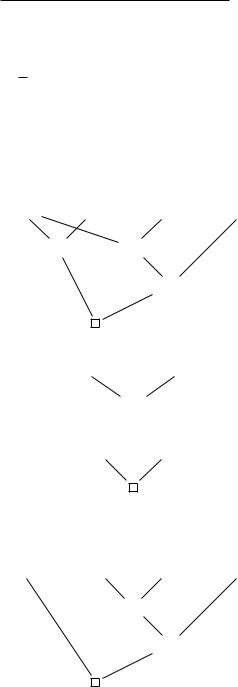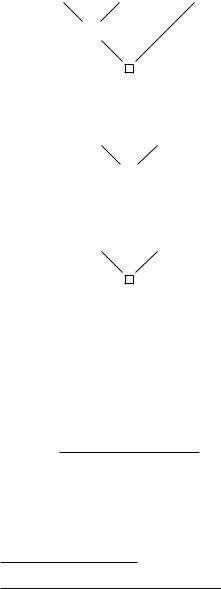

138 |
4/Resolution In Propositional Logic |
Γ, A1, ..., An →, where
Γ = {C2, ..., Cm} − {{A1, ¬P }, ..., {An, ¬P }}.
If {A1, ..., An} is a subset of Γ, then the tree obtained from T2 by replacing Γ by {C1, ..., Cm} is also a proof tree. By the induction hypothesis the number of leaves k in T2 is less than or equal to the number of resolution steps in D2, which is less than the number of resolution steps in D.
If {A1, ..., An} is not a subset of Γ, then, the following is a proof tree T in GCN F for C1, ..., Cm →.
T2 |
|
Γ, A1, ..., An → |
P, ¬P → |
P, Γ, {A1, ¬P }, ..., {An, ¬P } →
The number of axioms in T is k −1+1 = k, which is less than or equal to the number of resolution steps in D. In the special case where Γ, A1, ..., An → is an axiom, since C1, ..., Cm → is not a trivial sequent (the case of a trivial sequent being covered by the base case of a DAG with a single resolution step), there is some proposition in Γ, A1, ..., An which is the conjugate of one
of the Ai. Then, T2 is simply the axiom Ai, Ai →.
Case 2: Neither n1 nor n2 is a leaf. Let
{A1, P }, ..., {An, P }
be the set of terminal nodes of all paths from the node n1, such that every node in each of these paths contains P . Let D1 be the resolution DAG consisting of the descendant nodes of n1 (and n1 itself), and obtained by deleting P from every node in every path from n1 such that every node in such a path contains P . The root of D1 is labeled with the empty clause. By the induction hypothesis, there is a proof tree T1 in GCN F for Γ1, A1, ..., An →, where Γ1 is some subset of {C1, ...Cm}. By the induction hypothesis the number of axioms in T1 is less than or equal to the number m1 of resolution steps in D1. Similarly, let D2 be the DAG obtained by deleting all descendants of n1 that are not descendants of n2, and deleting all edges having these nodes as source, including the edges from n1, so that n1 is now a leaf. By the induction hypothesis, there is a proof tree T2 in GCN F with root labeled with Γ2, P →, where Γ2 is some subset of {C1, ..., Cm}.
If {A1, ..., An} is a subset of Γ1, then the tree T1 is also a proof tree for {C1,...,Cm}. Similarly, if P belongs to Γ2, the tree T2 is a proof tree for {C1,...,Cm}. Otherwise, we have the following proof tree T in GCN F :

4.3 The Resolution Method for Propositional Logic |
139 |
|||
|
T1 |
T2 |
||
|
|
|
|
|
|
Γ1, A1, ..., An → |
Γ2, P → |
||
Γ, {A1, P }, ..., {An, P } →
The special cases in which either Γ1, A1, ..., An → or Γ2, P → is an axiom is handled as in case 1. The details are left as an exercise. This completes the proof. 

Remark. Although it is tempting to claim that the number of resolution steps in D is m1 + m2, this is unfortunately false! The problem is that because a resolution refutation is a DAG, certain nodes can be shared.
EXAMPLE 4.3.7
Let D be the following resolution refutation:
{P, Q} |
{P, ¬Q} |
{¬P, Q} {¬P, ¬Q} |
|
{P } |
{Q} |
|
|
{¬P } |
Let D1 be the set of descendants of {P }: |
||
|
{P, Q} |
{P, ¬Q} |
{P}
Let D2 be the resolution refutation obtained by deleting P :
{Q} {¬Q}
Let D3 be the DAG obtained from D by deleting the descendants of {P } that are not descendants of {¬P }. Note that since {P, Q} is a descendant of {¬P }, it is retained. However, {P, ¬Q} is deleted.
{P } |
{P, Q} |
{¬P, Q} {¬P, ¬Q} |
{Q}
{¬P}

140 |
4/Resolution In Propositional Logic |
|
Let D4 be the resolution refutation obtained by deleting ¬P from all |
||
paths from {¬P } containing it: |
|
|
{P, Q} |
{¬P, Q} |
{¬Q} |
{Q} |
|
|
Let D5 be the set of descendants of {Q}:
{P, Q} {¬P, Q}
{Q}
Let D6 be the resolution refutation obtained from D5 by deleting Q:
{P } {¬P }
The method of theorem 4.3.3 yields the following proof trees: The tree
T1:
Q, ¬Q →
corresponds to D2; The tree T2:
Q, ¬Q → P, ¬P →
{P, Q}, {¬P, Q}, ¬Q →
corresponds to D4; The tree T3:
Q, ¬Q → P, ¬P →
{P, Q}, {¬P, Q}, ¬Q → P, ¬P →
P, {P, Q}, {¬P, Q}, {¬P, ¬Q} →
corresponds to D3; The tree T4:

4.3 The Resolution Method for Propositional Logic |
141 |
||||
|
Q, ¬Q → |
P, ¬P → |
|
|
|
|
{P, Q}, {¬P, Q}, ¬Q → |
|
P, ¬P → |
||
Q, ¬Q → |
P, {P, Q}, {¬P, Q}, {¬P, ¬Q} → |
|
|||
{P, Q}, {P, ¬Q}, {¬P, Q}, {¬P, ¬Q} →
corresponds to D. The number of axioms of T4 is four, which is the number of resolution steps in D. The next example shows that it is possible that the proof tree constructed from a resolution DAG has fewer leaves than the number of resolution steps.
EXAMPLE 4.3.8
Consider the following resolution refutation D:
{P, Q} |
{¬P, R} |
{¬Q} |
{¬R, P } |
{¬P } |
{Q, R} |
|
|
|
|
|
{R} |
|
{¬R} |
|
Let D1 be the DAG consisting of the descendants of {R}:
{P, Q} |
{¬P, R} |
{¬Q} |
{Q, R}
{R}
Let D2 be the DAG obtained from D1 by deleting R:
{P, Q} |
{¬P } |
{¬Q} |
{Q}
Note that D2 is a resolution for a subset of the set of clauses
{{P, Q}, {¬P, R}, {¬Q}, {¬R, P }, {¬P }}.
The construction recursively applied to D2 yields the following proof tree:

142 |
4/Resolution In Propositional Logic |
P, ¬P → |
Q, ¬Q → |
{P, Q}, ¬P, ¬Q →
From the above tree, we obtain the following proof tree for the original set of clauses:
P, ¬P → Q, ¬Q →
{P, Q}, {¬P, R}, ¬Q, {¬R, P }, ¬P →
This last tree has two leaves, whereas the DAG D has four resolution steps.
When the resolution DAG D is a tree, we still have the following lemma showing that the Gentzen system GCNF is basically as e cient as the resolution method.
Lemma 4.3.4 If a resolution refutation D is a tree with m nodes, then the proof tree T constructed by the method of theorem 4.3.3 has a number of nodes n such that, n ≤ 2m − 3.
Proof : Assume that D has r resolution steps. Since the tree T is binary branching and has k ≤ r leaves, it has n = 2k − 1 nodes. But the number m of nodes in the DAG D is such that, r + 1 ≤ m ≤ 2r + 1. Hence, n ≤ 2m − 3.
In the proof tree of example 4.3.7, there are two leaves labeled with P, ¬P → , and two leaves labeled with Q, ¬Q →. Hence, if this tree is represented as a DAG, it will have five nodes instead of seven. The original DAG has eight nodes. This suggests that the system GCNF using DAGs instead of trees is just as e cient as the resolution method. However, we do not have a proof of this fact at this time.
PROBLEMS
4.3.1. Show that the set of clauses
{{A, B, ¬C}, {A, B, C}, {A, ¬B}, {¬A}}
is unsatisfiable using the resolution method.
4.3.2.Show that the following sets of clauses are unsatisfiable using the resolution method:
(a) {{A, ¬B, C}, {B, C}, {¬A, C}, {B, ¬C}, {¬B}}
PROBLEMS |
143 |
(b){{A, ¬B}, {A, C}, {¬B, C}, {¬A, B}, {B, ¬C}, {¬A, ¬C}}
4.3.3.Construct a proof tree in GCN F for the set of clauses of problem 4.3.1, and convert it into a resolution DAG using the algorithm of theorem 4.3.1.
4.3.4.Construct proof trees in GCN F for the sets of clauses of problem 4.3.2, and convert them into resolution DAGs using the algorithm of theorem 4.3.1.
4.3.5.Convert the resolution DAG for the clause of problem 4.3.1 into a proof tree using the algorithm of theorem 4.3.3.
4.3.6.Convert the resolution DAGs for the clause of problem 4.3.2 into proof trees using the algorithm of theorem 4.3.3.
4.3.7.Find all resolvents of the following pairs of clauses:
(a){A, B}, {¬A, ¬B}
(b){A, ¬B}, {B, C, D}
(c){¬A, B, ¬C}, {B, C}
(d){A, ¬A}, {A, ¬A}
4.3.8.Construct a resolution refutation for the following set of clauses:
{{P, Q}, {¬P, Q}, {P, ¬Q}, {¬P, ¬Q}}.
Convert this resolution DAG into a proof tree using the algorithm of theorem 4.3.3
4.3.9.Another way of presenting the resolution method is as follows. Given a (finite) set S of clauses, let
R(S) = S {C | C is a resolvent of two clauses in S}.
Also, let
R0(S) = S,
Rn+1(S) = R(Rn(S)), n ≥ 0, and let
R (S) = Rn(S).
n≥0
(a)Prove that S is unsatisfiable if and only if R (S) is unsatisfiable.
(b)Prove that if S is finite, there is some n ≥ 0 such that
R (S) = Rn(S).

144 |
4/Resolution In Propositional Logic |
(c)Prove that there is a resolution refutation for S if and only if the empty clause 
 is in R (S).
is in R (S).
(d)Prove that S is unsatisfiable if and only if 
 belongs to R (S).
belongs to R (S).
4.3.10.Find R(S) for the following sets of clauses:
(a){{A, ¬B}, {A, B}, {¬A}}
(b){{A, B, C}, {¬B, ¬C}, {¬A, ¬C}}
(c){{¬A, ¬B}, {B, C}, {¬C, A}}
(d){{A, B, C}, {A}, {B}}
4.3.11.Prove that the resolution method is still complete if the resolution rule is restricted to clauses that are not tautologies (that is, clauses not containing both P and ¬P for some propositional letter P .)
4.3.12.We say that a clause C1 subsumes a clause C2 if C1 is a proper subset of C2. In the version of the resolution method described in problem 4.3.8, let
R1(S) = R(S) − {C | C is subsumed by some clause in R(S)}.
Let
R10 = S,
R1n+1(S) = R1(R1n(S)) and
R1 (S) = {R1n(S)}.
n≥0
Prove that S is unsatisfiable if and only if  belongs to R1 (S).
belongs to R1 (S).
4.3.13.Prove that the resolution method is also complete for infinite sets of clauses.
4.3.14.Write a computer program implementing the resolution method.
Notes and Suggestions for Further Reading
The resolution method was discovered by J.A. Robinson (Robinson, 1965). An earlier method for testing the unsatisfiability of a set of clauses is the DavisPutnam procedure (Davis and Putnam, 1960). Improvements due to Prawitz (Prawitz, 1960) and Davis (Davis, 1963) led to the resolution method. An exposition of resolution based on Gentzen sequents has also been given by J. Robinson (Robinson, 1969), but the technical details are di erent. To the best of our knowledge, the constructive method used in this chapter for proving the completeness of the resolution method by transforming a Gentzen-like proof is original.
Notes and Suggestions for Further Reading |
145 |
With J.A. Robinson, this author believes that a Gentzen-sequent based exposition of resolution is the best from a pedagogical point of view and for theoretical understanding.
The resolution method and many of its refinements are discussed in Robinson, 1969; Loveland, 1978; and in Chang and Lee, 1973.
Chapter 5
First-Order Logic
5.1 INTRODUCTION
In propositional logic, it is not possible to express assertions about elements of a structure. The weak expressive power of propositional logic accounts for its relative mathematical simplicity, but it is a very severe limitation, and it is desirable to have more expressive logics. First-order logic is a considerably richer logic than propositional logic, but yet enjoys many nice mathematical properties. In particular, there are finitary proof systems complete with respect to the semantics.
In first-order logic, assertions about elements of structures can be expressed. Technically, this is achieved by allowing the propositional symbols to have arguments ranging over elements of structures. For convenience, we also allow symbols denoting functions and constants.
Our study of first-order logic will parallel the study of propositional logic conducted in Chapter 3. First, the syntax of first-order logic will be defined. The syntax is given by an inductive definition. Next, the semantics of firstorder logic will be given. For this, it will be necessary to define the notion of a structure, which is essentially the concept of an algebra defined in Section 2.4, and the notion of satisfaction. Given a structure M and a formula A, for any assignment s of values in M to the variables (in A), we shall define the satisfaction relation |=, so that
M |= A[s]
146
5.2 FIRST-ORDER LANGUAGES |
147 |
expresses the fact that the assignment s satisfies the formula A in M.
The satisfaction relation |= is defined recursively on the set of formulae. Hence, it will be necessary to prove that the set of formulae is freely generated by the atomic formulae.
A formula A is said to be valid in a structure M if
M |= A[s]
for every assignment s. A formula A is valid (or universally valid) if A is valid in every structure M.
Next, we shall attempt to find an algorithm for deciding whether a formula is valid. Unfortunately, there is no such algorithm. However, it is possible to find a procedure that will construct a proof for a valid formula. Contrary to the propositional case, this procedure may run forever if the input formula is not valid. We will set up a proof system that is a generalization of the Gentzen system of Section 3.4 and extend the search procedure to firstorder formulae. Then, some fundamental theorems will be proved, including the completeness theorem, compactness theorem, and model existence theorem.
The two main concepts in this chapter are the search procedure to build proof trees and Hintikka sets. The main theme is that the search procedure is a Hintikka set constructor . If the search procedure fails to find a counter example, a proof is produced. Otherwise, the Hintikka set yields a counter example. This approach yields the completeness theorem in a very direct fashion. Another theme that will emerge in this chapter is that the search procedure is a very ine cient proof procedure. The purpose of the next chapters is to try to find more e cient proof procedures.
5.2 FIRST-ORDER LANGUAGES
First, we define alphabets for first-order languages.
5.2.1 Syntax
In contrast with propositional logic, first-order languages have a fixed part consisting of logical connectives, variables, and auxiliary symbols, and a part that depends on the intended application of the language, consisting of predicate, function, and constant symbols, called the non logical part.
Definition 5.2.1 The alphabet of a first-order language consists of the following sets of symbols:
Logical connectives: (and), (or), ¬ (not), (implication), ≡ (equivalence),. (falsehood); quantifiers: (for all), (there exists); the equality symbol =.
